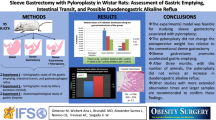Summary
In an animal experiment the role of bile reflux in development of anastomotic ulcer after partial gastrectomy was investigated. On 45 pigs 2/3 partial gastrectomies and on 5 animals only laparotomies were carried out. The ulcer risk after reconstruction procedures with possible bile reflux was compared with reflux-free techniques. Anastomotic ulcer developed after maximal exposure of the gastric remnant to bile as well as after reflux-free reconstructions: B-II-Roux, 40 cm jejunum loop (n=5/10); B-II-Roux, 20 cm jejunum loop (n=3/5); B-II-Roux, 40 cm jejunum loop and truncal vagotomy (n=1/5); B-I and choledochojejunostomy (n=2/10); BII-Roux, 40 cm jejunum loop and Choecystogastrostomy (n=4/5). After B-I resection with medium duodeno-gastric reflux (n=0/10) and in the control group (n=015, laparotomy only) no ulcer occurred. Because basal acid output after B-I and B-II-Roux resection was reduced to O mval/h, stimulated gastric acid seems to be important in development of anastomotic ulcer. The experimental results prove the protective role of postresectional duodenogastric reflux. After partial gastrectomy for primary ulcer surgery reconstruction procedures guaranteeing duodenogastric reflux should be preferred to Roux-en-Y gastrojejunostomy.
Zusammenfassung
Die Bedeutung des Gallerefluxes nach Magenresektion für die Entstehung von Anastomosenulzera wurde tierexperimentell untersucht. Hierzu erfolgten bei 45 Hausschweinen 2/3-Magenresektionen und bei 5 Tieren eine Probelaparotomie. Refluxverhütende und refluxbelastete Formen der Passagerekonstruktion Roux, 40-cm-Schlinge (n=5/10); B-II-Roux, 20-cm-Schlinge (n=3/5); B-II-Roux, 40-cm-Schlinge mit trunkulärer Vagotomie (n=1/5); B-I mit Choledochojejunostomie (n=2/10) and B-II-Roux, 40-cm-Schlinge mit Cholezystogastrostomie (n=4/5). Nach B-I-Resektion mit Gewährleistung eines mittleren duodenogastralen Refluxes (n=0110) and in der Kontrollgruppe (Probelaparotomie,n=0/5) traten keine Ulzera auf. Als Ursache der Anastomosenulzera nach refluxverhütender Rekonstruktion muß, da experimentell die basale Säuresekretion nach B-I- wie B-II-Roux-Magenresektion ausgeschaltet werden konnte, zephalisch, gastral oder intestinal stimulierte, nicht durch duodenales Refluat gepufferte Säure diskutiert werden. Die erhobenen tierexperimentellen Befunde belegen den ulkusprotektiven Charakter des postresektionellen duodenalen Refluates. Sie sprechen gegen die klinische Anwendung der refluxverhütenden Gastrojejunostomie nach Roux als primäre Rekonstruktion nach Magenresektion wegen gastroduodenaler Ulzera und für Verfahren, die einen duodenogastralen Reflux gewährleisten.
Similar content being viewed by others
Literatur
Arlt G, Schumpelick V, Klöppel G (1984) Das TJlcusrisiko des Roux-Y-Magens. Langenbecks Arch Chir 362:43–52
Baumann M, Arlt G, Winkeltau G, Schumpelick V (1988) Bedeutung von Pankreas- und Duodenalsekreten für die Protektion gastroenteraler Anastomosen nach Magenresektion — eine tierexperimentelle Studie. Langenbecks Arch Chir 373:109–113
Bell AE, Selbers LA, Allen A, Cunliffe WJ, Morris ER, Ross-Murphy SB (1985) Properties of gastric and duodenal mucus, effect of proteolysis disulfide reduction, bileacid, ethanol, and hypertonicity on mucus gel structure. Gastroenterology 88:269–280
Black RB, Hole D, Rhodes J (1971) Bile damage to the gastric mucosal barrier: the influence of pH and bile acid concentration. Gastroenterology 61:178–184
Borgström B (1957) Studies of the phospholipids of human bile and small intestinal contents. Acta Chem Scand 11:749
Capucci DT jr (1967) Porcine gastric ulcers in the United States: a review. Veterinarian 4:213–218
Chlumskij V (1898) Ueber die Gastroenterostomie. Statistische und experimentelle Studien. Beitr Klin Chir 20:231–274 and 487–544
Flemström G, Kivilaakso E (1983) Demonstration of a pH gradient at the luminal surface of rat duodenum in vivo and its dependence on mucosal alkaline secretion. Gastroenterology 84:787:794
Florey HW, Wright RD, Jennings MA (1941) The secretions of intestine. Physiol Rev 21:36–39
Houghton PWJ, Mortensen NJ McC, Williamson RCN (1987) Effect of duodenogastric reflux on gastric mucosal proliferation after gastric surgery. Br J Surg 74:288–291
Kowalczyk T, Muggenburg BA (1963) Recent developments in gastric ulcers in swine. Proc 17th World Vet Congress 2:1311–1314
Langhans P, Heger RA, Hohenstein J, Bünte H (1981) Operation — sequel carcinoma — an experimental study. Hepatogastroenterology 28:34–37
Lawson HH (1964) Effect of duodenal contents on the gastric mucosa under experimental conditions. Lancet 1:469–472
Malfertheimer P, Junge U, Ditschuneit H (1984) Pancreatic digestive function after subtotal gastrectomy — evaluation by an indirect method. Hepatogastroenterology 31:172–175
Mann FC, Wiliamson CS (1923) Experimental ulcer production. Ann Surg 77:409–422
Mason RC (1986) Duodenogastric reflux in rat gastric carcinoma. Br J Surg 73:801–803
Mason RC, Taylor PR, Filipe MJ, McColl J (1988) Pancreaticoduodenal secretions and the genesis of gastric stump carcinoma in the rat. Gut 29:830–834
Miller TA (1988) Gastroduodenal mucosal defense: factors responsible for the ability of the stomach and duodenum to resist injury. Surgery 103:389–397
Moeller H, Sewing K-F, Greisbe H, Schmolke M (1974) Gastric acid secretion in conscious miniature pigs. Naunyn Scbmiedebergs Arch Pharmacol 283:83–92
Reed PI, Smith PLR, Haines K, House FR, Walters CL (1981) Gastric juice N-nitrosoamines in health and gastroduodenal disease. Lancet 1:550–552
Riechert B, Schumpelick V, Kremer B (1987) Ulcusrisiko nach Umwandlungsoperationen von B-1-Mägen in refluxverhütende Reparationsverfahren-eine tierexperimentelle Studie. Langenbecks Arch Chir 371:253–262
Ritchie WP (1980) Alkaline reflux gastritis. An objective assessment of its diagnosis and treatment. Ann Surg 192:288–296
Rokkjaer M, Sögaard H, Kruse A, Amdrup E (1977) Bile induced chronic gastric ulcer in swine. World J Surg 1:371–379
Schlag P, Wonka W, Meyer H, Feyerabend G, Merkle P (1977) Bakterielle Besiedlung und Nitritbildung im Magen nach Gastroenterostomie. Langenbecks Arch Chir 344:109–114
Sherenesheva NJ, Patjutko JI, Klimenkov AA, Turusov VS (1987) Experimental carcinoma of the stomach in rats with chronic ulcers and following gastric surgery. Arch Geschwulstforsch 57:91–98
Smith GM (1914) An experimental study of the relation of bile to ulceration of the mucuos membrane of the stomach. J Med Res 30:147–183
Thomas WEG (1980) Functional changes in acid secretion produced by duodeno-gastric reflux. Gut 21:413–417
Walgenbach S, Eissner D, Hahn K, Schicketanz KH, Schrezenmeir J, Junginger Th (in Vorbereitung) Gastric emptying and release of pancreatic polypeptide after gastrectomy with and without retention of the duodenal passage
Werther JL, Janowitz HD, Dyck WP, Chapman ML, Rudick J (1970) The effect of bile on electrolyte movement across canine gastric antral and fundic mucosa. Gastroenterology 59:691–697
Author information
Authors and Affiliations
Rights and permissions
About this article
Cite this article
Walgenbach, S., Junginger, T., Hage, C. et al. Tierexperimentelle Untersuchungen zur Genese von Anastomosenulzera nach refluxbelasteter und refluxverhütender Magenresektion. Langenbecks Arch Chiv 376, 69–76 (1991). https://doi.org/10.1007/BF01263463
Received:
Issue Date:
DOI: https://doi.org/10.1007/BF01263463




